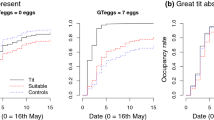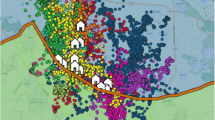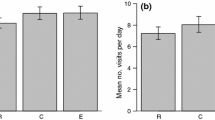Abstract
In migratory birds individuals may prospect for potential breeding sites months before they attempt to breed and should use the cues most predictive of future reproductive success when selecting a breeding site. However, what cues individuals use when prospecting and which cues are used in selecting a breeding site are unknown for most species. I investigated whether yellow-headed blackbirds (Xanthocephalus xanthocephalus) prospect for future breeding sites and whether they select breeding habitats based on food availability, male or female density, or the average number of young produced per female in the previous year. Although it is often assumed that migratory birds prospect for potential breeding sites at the end of the breeding season, I investigated this by recording all visits to sites early and late in the breeding season. I found that males and females who visited sites other than the site at which they bred were more likely to disperse than individuals only observed at the site where they bred, and that males and females were more likely to prospect late in the breeding season. Both food availability and density in yearx were not predictive of the number of young per female in yearx+1; however, the number of young produced per female at a site in yearx was predictive of the number of young per female in yearx+1. As expected, dispersers used the most informative cue, the number of young per female and moved to sites with a relatively high number of young per female. This study suggests that individuals prospect for potential breeding sites late in the breeding season when they can use information gathered from the reproductive success of other individuals (i.e., public information) to select a breeding site.




Similar content being viewed by others
References
Boulinier T, Danchin E (1997) The use of conspecific reproductive success for breeding patch selection in territorial migratory species. Evo Eco 11:505–517
Boulinier T, Lemel J-Y (1996) Spatial and temporal variation of factors affecting breeding habitat quality in colonial birds: some consequences for dispersal and habitat selection. Acta Oecol 17:531–552
Boulinier T, Danchin E, Monnat J-Y, Doutrelant C, Cadiou B (1996) Timing of prospecting and the value of information in a colonial breeding bird. J Avian Biol 27:252–256
Brown CR, Brown MB (1996) Coloniality in the Cliff Swallow. University of Chicago Press, Chicago
Brown M, Dinsmore JJ (1986) Implications of marsh size and isolation for marsh bird management. J Wildl Manage 50:392–397
Brown CR, Brown MB, Danchin E (2000) Habitat selection in cliff swallows: the effect of conspecific reproductive success on dispersal and recruitment decisions in a colonial bird. J Anim Ecol 69:133–142
Cadiou B, Monnat, J-Y, Danchin, E (1994) Prospecting in the kittiwake, Rissa tridactyla: different behavioral patterns and the role of squatting in recruitment. Anim Behav 47:847–856
Cam E, Cadiou B, Hines JE, Monnat J-Y (2002) Influence of behavior tactics on recruitment and reproductive trajectory in the kittiwake. J Applied Stat 29:163–185
Danchin E, Cam E (2002) Can non-breeding be a cost of breeding dispersal? Behav Ecol Sociobiol 51:153–163
Danchin E, Boulinier T, Massot M (1998) Conspecific reproductive success and breeding habitat selection: implications for the study of coloniality. Ecology 79:2415–2428
Danchin E, Heg D, Doligez B (2001) Public information and breeding habitat selection. In: Clobert J, Danchin E, Dhondt AA, Nichols JD (eds) Dispersal. Oxford University Press, pp 24–260
Danchin E, Giraldeau L-A, Valone TJ, Wagner RH (2004) Public information: from nosy neighbors to cultural evolution. Science 305:487–491
Doligez B, Danchin E, Clobert J, Gustafsson L (1999) The use of conspecific reproductive success for breeding habitat selection in a non-colonial, hole nesting species, the collared flycatcher, Ficedula albicollis. J Anim Ecol 68:1–15
Doligez B, Danchin E, Clobert J (2002) Public information and breeding habitat selection in a wild bird population. Science 297:1168–1170
Doligez B, Cadet C, Danchin E, Boulinier T (2003) When to use public information for breeding habitat selection? The role of environmental predictability and density dependence. Anim Behav 66:973–988
Doligez B, Pärt T, Danchin E (2004a) Prospecting in the collared flycatcher: gathering public information for future breeding habitat selection. Anim Behav 67:457–466
Doligez B, Pärt T, Danchin E, Clobert J, Gustafsson L (2004b) Availability and use of public information and conspecific density for settlement decisions in the collared flycatcher. J Anim Ecol 73:75–87
Forbes LS, Kaiser GW (1994) Habitat choice in breeding seabirds—when to cross the information barrier. Oikos 70:377–384
Forbes S, Grosshans R, Glassey B (2002) Multiple incentives for parental optimism and brood reduction in blackbirds. Ecology 83:2529–2541
Fretwell SD, Lucas HL (1970) On territorial behavior and other factors influencing habitat distribution in birds I Theoretical development. Acta Biotheor 19:19–36
Giraldeau LA, Valone TJ, Templeton JJ (2002) Potential disadvantages of using socially-acquired information. Phil Trans R Soc Lon B 357:1559–1566
Lightbody JP, Weatherhead PJ (1987) Polygyny in the yellow-headed blackbird: female choice versus male competition. Anim Behav 35:1670–1684
Martin TE (1998) Are microhabitat preferences of coexisting species under selection and adaptive? Ecology 79:656–670
Matthysen E, Adriaensen F, Dhondt AA (2001) Local recruitment of great and blue tits (Parus major, P caeruleus) in relation to study plot size and degree of isolation. Ecography 24:33–42
Muller KL, Stamps JA, Krishnan VV, Willits NH (1997) The effects of conspecific attraction and habitat quality on habitat selection in territorial birds (Troglodytes aedon). Am Nat 150:650–661
Orians GH (1966) Food of nestling yellow-headed blackbirds, Cariboo Parklands, British Columbia. Condor 68:321–337
Orians GH (1980) Some adaptations of marsh-nesting blackbirds. Princeton University Press, Princeton
Orians GH, Horn HS (1969) Overlap in food and foraging of four species of blackbirds in the potholes of central Washington. Ecology 50:930–938
Orians GH, Wittenberger JS (1991) Spatial and temporal scales in habitat selection. Am Nat 137:s29–s49
Ottoson U, Backman J, Smith HG (2001) Nest-attenders in the pied flycatcher (Ficedula hypoleuca) during nestling rearing: a possible case of prospective resource exploration. Auk 118:1069–1072
Pärt T (1994) Male philopatry confers a mating advantage in the migratory collared flycatcher, Ficedula albicollis. Anim Behav 48: 401–409
Pärt T, Doligez B (2003) Gathering public information for habitat selection: prospecting birds cue on parental activity. Proc R Soc Lon B 270:1809–1813
Perrins CM, McCleery RH (2001) The effects of fledgling mass on the lives of great tits Parus major. Ardea 89:135–142
Reed JM, Boulinier T, Danchin E, Oring LW (1999) Informed dispersal: prospecting by birds for breeding sites. Curr Ornithol 15:189–259
Schjørring S, Gregersen J, Bregnballe T (1999) Prospecting enhances breeding success of first-time breeders in the great cormorant, Phalacrocorax carbeo sinensis. Anim Behav 57:647–654
Serrano D, Tella JL, Forero MG (2001) Factors affecting breeding dispersal in the facultatively colonial lesser kestrel: individual experience vs. conspecific cues. J Anim Ecol 70:568–578
Slagsvold T (1987) Nest site preferences and clutch size in the pied flycatcher, Ficedula hypoleuca. Ornis Scand 12:189–197
Sutherland WJ (1998) The importance of behavioural studies in conservation biology. Anim Behav 56:801–809
Turner AT, McCarty JP (1998) Resource availability, breeding site selection, and reproductive success of red-winged blackbirds. Oecologia 113:140–146
Valone TJ (1989) Group foraging, public information, and patch estimation. Oikos 56:357–363
Ward MP (2004) Habitat selection by yellow-headed blackbirds. PhD Thesis, University of Illinois
Ward MP (2005) The role of immigration in the decline of an isolated migratory bird population. Cons Biol (in press)
Ward MP, Schlossberg S (2004) Conspecific attraction and the conservation of territorial songbirds. Cons Biol 18:519–525
Ward MP, Weatherhead PJ (2005) Sex-specific differences in site fidelity and the cost of dispersal in yellow-headed blackbirds. Behav Ecol Sociobiol (in press)
Wiggens DA, Pärt T, Gustafsson L (1994) Seasonal declines in collared flycatcher, Ficedula albicolis reproductive success: an experimental approach. Oikos 70:359–364
Willson MF (1966) Breeding ecology of the yellow-headed blackbirds. Ecol Monogr 36:51–77
Acknowledgements
I thank Dave Enstrom, Pat Weatherhead, Scott Robinson, Jim Herkert, Brad Semel, Ken Paige, and Jeff Brawn for advice and support. I would also like to thank the tremendous work of several field assistants. Financial support for this study was provided by Illinois Natural History Survey, Illinois Department of Transportation, Illinois Department of Natural Resources, Champaign County Audubon Society, Sigma Xi, Max McGraw Wildlife Foundation, Chicago Wilderness, IDNR /Chicago Wilderness C-2000 partnership, Chicago Zoological Society, Zoos for Environmental Conservation, US Fish and Wildlife Service, McHenry County Conservation Foundation, Illinois Endangered Species Board, and the University of Illinois at Urbana-Champaign. This research was conducted in accordance with the University of Illinois Urbana-Champaign Animal Care and Use Permit#N8C093.
Author information
Authors and Affiliations
Corresponding author
Additional information
Communicated by Scott Robinson
Rights and permissions
About this article
Cite this article
Ward, M.P. Habitat selection by dispersing yellow-headed blackbirds: evidence of prospecting and the use of public information. Oecologia 145, 650–657 (2005). https://doi.org/10.1007/s00442-005-0179-0
Received:
Accepted:
Published:
Issue Date:
DOI: https://doi.org/10.1007/s00442-005-0179-0




